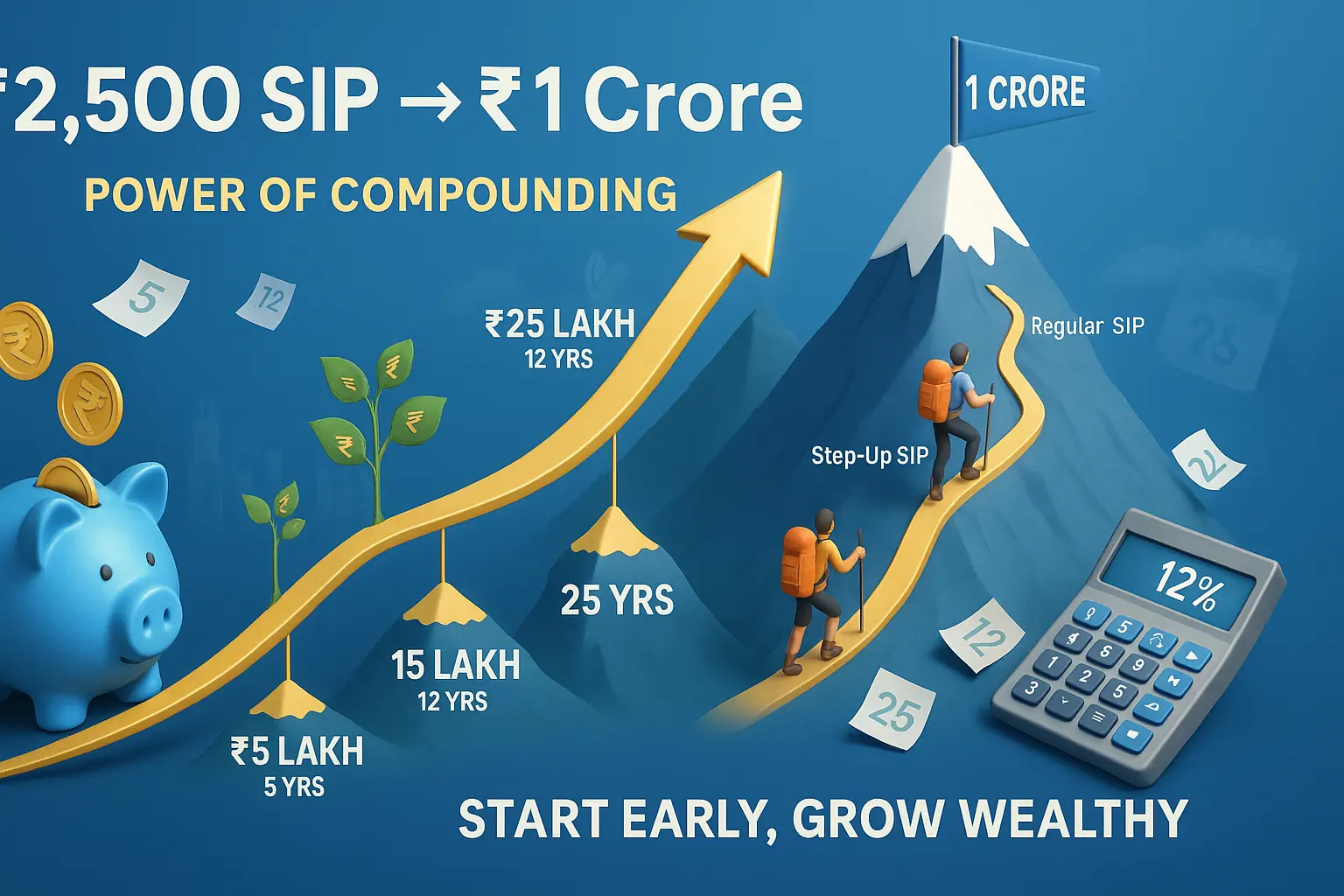What is a SIP Calculator?
A Systematic Investment Plan (SIP) calculator is a powerful digital tool that helps investors estimate the potential returns from their regular mutual fund investments. By factoring in the amount, duration, and expected returns, it projects how your money can grow through the magic of compounding interest.
Why SIP Calculators Are Essential for Investors
- Visualize long-term wealth creation potential
- Set realistic financial goals for milestones like retirement or education
- Compare different investment scenarios instantly
- Understand the impact of increasing SIP amounts over time
- Make informed decisions before committing to an investment plan
How SIP Calculators Work: The Math Behind the Magic
The SIP Calculation Formula
All SIP calculators use this standard formula:
Future Value = P × [(1+r)^n - 1] × (1+r)/r
Where:
P = Monthly investment amount
r = Expected monthly return rate (annual return ÷ 12)
n = Total number of months (years × 12)Example Calculation
For ₹5,000 monthly SIP for 15 years at 12% annual return:
- Monthly return (r) = 12%/12 = 1% = 0.01
- Total months (n) = 15 × 12 = 180
- Future Value = 5000 × [(1+0.01)^180 – 1] × (1+0.01)/0.01
- Result = ₹24,97,627 (₹25 lakhs approx.)
How to Use a SIP Calculator: Step-by-Step Guide
- Enter Monthly Investment Amount
- Start with what you can afford (even ₹500/month)
- Consider future step-up possibilities
- Select Investment Duration
- Short-term (3-5 years)
- Medium-term (5-10 years)
- Long-term (10+ years)
- Input Expected Return Rate
- Conservative estimate: 10-12% for equity funds
- Moderate: 12-14% for sectoral funds
- Aggressive: 15%+ for small-cap funds
- Review Results
- Total invested amount
- Estimated maturity value
- Wealth gained through compounding
- Adjust Parameters
- Try different durations
- Test higher/lower SIP amounts
- Compare return scenarios
5 Key Advantages of Using a SIP Calculator
- Goal Planning
- Determine how much to invest for specific targets
- Example: ₹25,000/month for 15 years at 12% = ₹1 crore
- Visualize Compounding
- See how small regular investments grow exponentially
- ₹10,000/month for 30 years at 12% = ₹3.5 crores
- Compare Scenarios
- Early vs late start
- Fixed SIP vs step-up SIP
- Different return assumptions
- Informed Decision Making
- Choose funds matching your return expectations
- Balance risk with projected outcomes
- Performance Tracking
- Compare actual vs projected returns
- Make mid-course corrections.
Note: Actual implementation requires JavaScript calculation logic
Frequently Asked Questions
1. How accurate are SIP calculators?
SIP calculators provide mathematical projections based on your inputs. However:
- They assume constant returns (markets fluctuate)
- Don’t account for fund expense ratios (typically 1-2%)
- Don’t factor in taxes (10% LTCG over ₹1 lakh)
- Use them for estimation, not guarantees
2. What return rate should I use?
Conservative estimates based on historical performance:
- Large-cap funds: 10-12%
- Flexi-cap funds: 12-14%
- Mid/small-cap funds: 14-16%
- Subtract 1-2% for safety margin
3. How does inflation affect SIP calculations?
Always consider inflation:
- ₹1 crore in 20 years ≈ ₹30 lakhs today (at 6% inflation)
- Use real returns (return % – inflation %) for practical value
4. When should I increase my SIP amount?
Ideal times to step-up:
- Annual salary increments
- After paying off loans
- When getting bonuses
- Rule of thumb: Increase by 10% yearly if possible
5. Can I withdraw SIP money anytime?
Yes, but:
- Equity funds have exit load for early redemption (1% for <1 year)
- Short-term gains taxed at 15%
- Long-term (held >1 year) gains over ₹1 lakh taxed at 10%
6. How is SIP different from lump-sum investment?
| Parameter | SIP | Lump-Sum |
|---|---|---|
| Market Timing | Averages purchase price | Needs timing expertise |
| Risk | Lower | Higher |
| Minimum Amount | ₹500/month | ₹5,000+ |
| Best For | Regular income earners | Those with large sums |
Pro Tips for Maximizing SIP Returns
- Start Early Advantage
- ₹10,000/month at 12% for:
- 20 years: ₹99 lakhs
- 30 years: ₹3.5 crores
- The extra 10 years nearly quadruples returns
- Step-Up Strategy
- Increase SIP by 10% annually
- ₹5,000 starting SIP becomes ₹8,000 in 5 years
- Can reduce target duration by 3-5 years
- Portfolio Diversification
- Blend large, mid, and small-cap funds
- Add international funds for global exposure
- Consider debt funds for stability
- Tax Efficiency
- ELSS funds offer 80C deduction (₹1.5 lakh limit)
- Hold equity funds >1 year for lower tax
- Use index funds for lower expense ratios
Top 5 SIP Calculator Tools
- Moneycontrol SIP Calculator – Most detailed with inflation adjustment
- Groww SIP Calculator – Simple interface with graphical outputs
- ET Money SIP Planner – Goal-based calculations
- Value Research Calculator – Compare multiple scenarios
- Kuvera SIP Projector – Shows year-by-year growth
Common SIP Mistakes to Avoid
- Stopping During Market Dips (Missing buying opportunities)
- Chasing Past Performance (High returns may not repeat)
- Ignoring Expense Ratios (1% fee reduces returns by 20% over 20 years)
- Not Reviewing Annually (Rebalancing is crucial)
- Overlooking Tax Implications (Short-term vs long-term gains)
Final Thoughts
SIP calculators are powerful planning tools, but remember:
- They show potential, not guarantees
- Actual returns will vary year-to-year
- The most important factor is staying invested
- Consistency beats timing the market
-
“mutual fund SIP calculator”
-
“SIP return calculator”
-
“how to use SIP calculator”
-
“SIP investment growth”
Ready to start? Use our calculator above to find your ideal SIP plan today!
Disclaimer: Mutual fund investments are subject to market risks. Past performance doesn’t guarantee future returns. Consult a financial advisor before investing.


